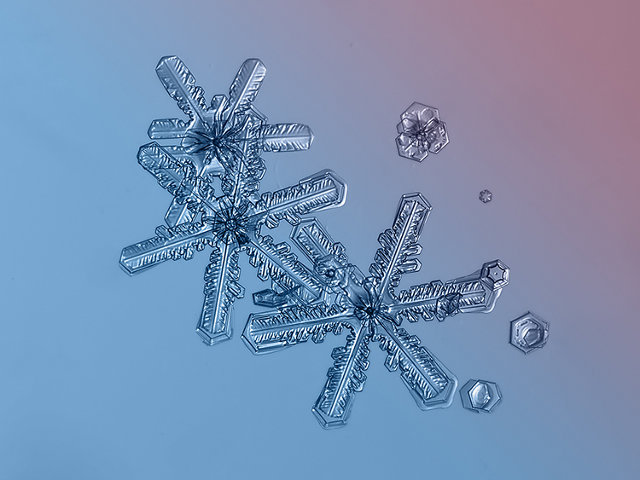Snowflakes teach us many lessons when we're children. It teaches us about the fractal beauty that lies beneath all things; it teaches us about uniqueness, patterns, and infinity. But for some reason, we forget the secret beauty of the snowflake. When we look out the window on a snowy day, we stop seeing a scintillating sea of microscopic crystals too vast to count. We just see a cold, dreary slurry, dirtied by boots and melting in the sun.
Russian photographer Alexey Kljatov might just teach you to appreciate the geometric beauty of snowflakes again. Using very simple techniques, his macro-photography makes individual snowflakes look like otherworldly castles, frozen in space as well as time.

One thing that is remarkable about Kijatov's work is that it was all accomplished with a very low-end camera: a Canon PowerShot A650 that tops out at a relatively scant 12.1 megapixels. Costing less than $200 on eBay, this is hardly a cutting-edge camera. In fact, featuring a mere 6x optical zoom, Kijatov's camera seems seems totally unsuited to the task of taking the sorts of photographs Kijatov routinely comes up with. The pictures Kijatov takes look like they were taken with a camera that cost 10 times as much, or more.
Taking shots from his balcony at night, Kijatov shoots his snowflakes using two different techniques. For top-down views, he allows a snowflake to fall on a plate of glass, then uses an LED flashlight to illuminate the snowflake from below. Keeping it steady with a plastic bottle, Kijatov keeps his lens just 1 centimeter away from the snowflake's surface, then uses his camera's autofocus to capture multiple shots of each magnified chip of ice. These shots are then averaged together and colored for emphasis, resulting in the beautiful finished shots you see above.

That's all impressive enough, to be sure, but for his most spectacular shots, Kijatov relies upon one more piece of kit: an old Helios 44M-5 lens from an old Soviet SLR camera. By taping his PowerShot together with the Helios and wrapping them in a plastic bag so no outside light creeps through, Kijatov is able to supercharge his cheap camera's ability to take pictures of the hidden geometric world that underlies every snowy winter day.
What's so great about Kijatov's work is how much it shows us what we take for granted, not just about the microscopic world around us, but about the power of the cheap digicams and rusty old lenses we dismiss and discard every day. Make sure to check out Kijatov's blog for more.